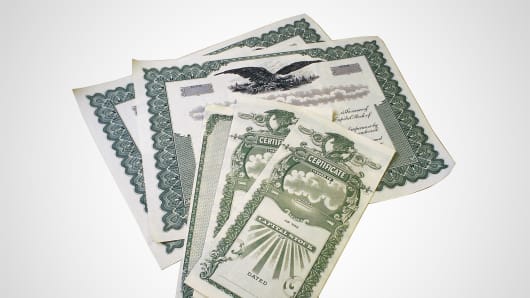Prices for U.S. Treasurys fell on Tuesday as investors looked ahead to retail sales data to shed light on consumer habits on Wednesday after a lackluster debt sale, the first for a total of $72 billion in supply this week.
The Treasury sold $32 billion in three-year notes on Tuesday, its first sale of coupon debt this week.
"It was pretty weak given how cheap the three-year was in our view," said Jim Vogel, interest rate strategist at FTN Financial in Memphis.
Instead, investors are looking to retail sales data for January, due on Wednesday, he said. Investors will be looking for signs that a bump in payroll taxes is prodding people to hold onto more of their paychecks.
"I think a lot of people are primed not necessarily to think about the 10-year auction until we get through retail sales tomorrow," Vogel said.
The Treasury will sell $24 billion in 10-year notes on Wednesday and $16 billion in 30-year bonds on Thursday.
Earlier in the session comments from an official with the Group of Seven that it is worried about excess moves in the Japanese currency sparked a round of short covering.
Investors interpreted the new comments from the G7 official as meaning that the group did not support moves in the Japanese yen, as was thought after the G7 said in an official statement that it is committed to "market-determined" exchange rates.
It "prompted a bout of short covering in Treasurys," said Dan Mulholland, managing director in Treasurys trading at BNY Mellon in New York.
Benchmark 10-year notes were last down 5/32 in price to yield 1.982 percent.
Sequestration "Complacency"
Analysts at Barclays see Treasurys yields as likely to fall in coming weeks as more investors focus on the probability that the $85 billion of spending cuts will be implemented on March 1.
"I think there has been a lot of complacency. It would be a 30-basis-point hit to gross domestic product, which isn't really penciled in by a lot of people," said Rajiv Setia, head of U.S. rates research at Barclays in New York.
The issue raises a dilemma for lawmakers as the implementation of the cuts threatens to slow economic growth, though the failure to stabilize the country's rising debt levels would increase the prospect of further U.S. ratings downgrades and pose longer-term problems for the economy.
Treasurys yields surged in January after a last-minute agreement to avoid the "fiscal cliff" spurred risk taking and reduced the safety demand for U.S. bonds, though Barclays sees this selloff as overdone.
"The selloff in rates since the fiscal cliff deal has clearly overshot," said Setia. "I think we'll go through medium-term austerity in the U.S. We are the only developed country that hasn't implemented a program."
Benchmark 10-year notes yields jumped from 1.70 percent at year-end as high as 2.06 percent on Feb. 4 before falling back.
(Read More: Why 10-Year Notes Could Suffer a Dramatic Sell Off)
Setia said that there is resistance at around 1.90 to 1.92 percent, and if yields drop back below this level, they are likely to fall further to around 1.80 percent.
Barclays sees the notes ending the year at around 1.60 percent as investors adjust to slower growth than is currently projected.
(Read More: Short US Government Bonds 'Right Now': Jim Rogers)
President Barack Obama's State of the Union address will be closely watched on Tuesday night for signs of whether Congress is likely to reach a deal to avert cuts.
In addition, the Federal Reserve bought $3.31 billion in debt due 2020-22 on Tuesday as part of its ongoing bond purchase program meant to stimulate the economy.


